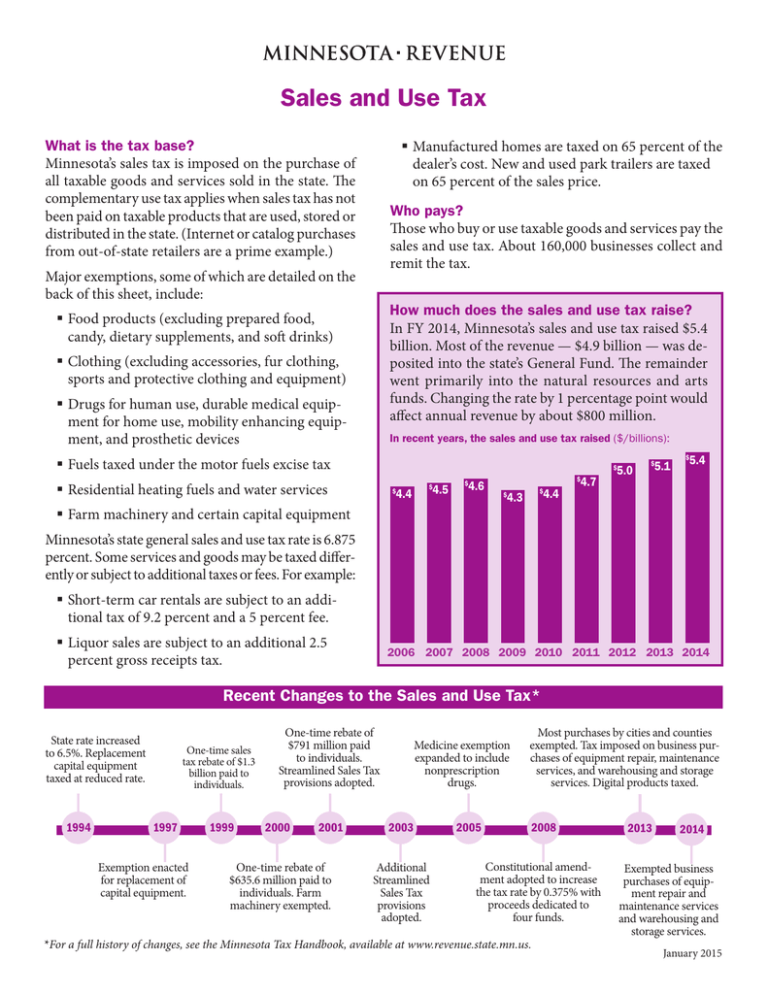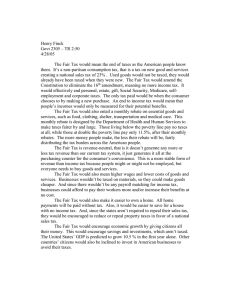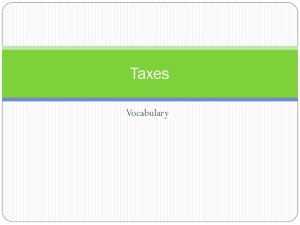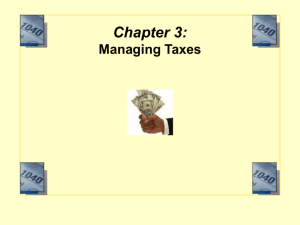Sales and Use Tax - Minnesota Department of Revenue
advertisement

Sales and Use Tax Manufactured homes are taxed on 65 percent of the dealer’s cost. New and used park trailers are taxed on 65 percent of the sales price. What is the tax base? Minnesota’s sales tax is imposed on the purchase of all taxable goods and services sold in the state. The complementary use tax applies when sales tax has not been paid on taxable products that are used, stored or distributed in the state. (Internet or catalog purchases from out-of-state retailers are a prime example.) Who pays? Those who buy or use taxable goods and services pay the sales and use tax. About 160,000 businesses collect and remit the tax. Major exemptions, some of which are detailed on the back of this sheet, include: How much does the sales and use tax raise? In FY 2014, Minnesota’s sales and use tax raised $5.4 billion. Most of the revenue — $4.9 billion — was deposited into the state’s General Fund. The remainder went primarily into the natural resources and arts funds. Changing the rate by 1 percentage point would affect annual revenue by about $800 million. Food products (excluding prepared food, candy, dietary supplements, and soft drinks) Clothing (excluding accessories, fur clothing, sports and protective clothing and equipment) Drugs for human use, durable medical equipment for home use, mobility enhancing equipment, and prosthetic devices In recent years, the sales and use tax raised ($/billions): Fuels taxed under the motor fuels excise tax 5.0 $ Residential heating fuels and water services 4.4 $ 4.5 $ 4.6 Farm machinery and certain capital equipment 4.7 $ $ 4.4 $ 4.3 $ 5.1 $ 5.4 $ Minnesota’s state general sales and use tax rate is 6.875 percent. Some services and goods may be taxed differently or subject to additional taxes or fees. For example: Short-term car rentals are subject to an additional tax of 9.2 percent and a 5 percent fee. Liquor sales are subject to an additional 2.5 percent gross receipts tax. 2006 2007 2008 2009 2010 2011 2012 2013 2014 Recent Changes to the Sales and Use Tax* State rate increased to 6.5%. Replacement capital equipment taxed at reduced rate. 1994 One-time sales tax rebate of $1.3 billion paid to individuals. 1997 Exemption enacted for replacement of capital equipment. 1999 One-time rebate of $791 million paid to individuals. Streamlined Sales Tax provisions adopted. 2000 2001 One-time rebate of $635.6 million paid to individuals. Farm machinery exempted. Medicine exemption expanded to include nonprescription drugs. 2003 Additional Streamlined Sales Tax provisions adopted. 2005 Most purchases by cities and counties exempted. Tax imposed on business purchases of equipment repair, maintenance services, and warehousing and storage services. Digital products taxed. 2008 Constitutional amendment adopted to increase the tax rate by 0.375% with proceeds dedicated to four funds. *For a full history of changes, see the Minnesota Tax Handbook, available at www.revenue.state.mn.us. 2013 2014 Exempted business purchases of equipment repair and maintenance services and warehousing and storage services. January 2015 Major exemptions The list below covers what is taxable and exempt for selected major goods and services. For a full listing of exemptions, see the Minnesota Tax Expenditure Budget. Food products Clothing Taxed: Food and drinks prepared by a retailer, including food served by a restaurant or sold in vending machines; candy, dietary supplements, soft drinks, and alcoholic beverages. Taxed: Jewelry, handbags, billfolds, fur clothing, sports clothing sold for exclusive use in a sporting activity, and protective equipment. Exempted: Most food and food ingredients for human use, including meats, dairy, vegetables, fruits, cereals, coffee, tea, spices, and sugar. Exempted: Clothing for general use, footwear, headgear, belts, hosiery, gloves and mittens. Also exempted are sewing materials such as fabrics, thread, buttons, zippers, and similar items that are used in clothing. Cost to State: $685 million (FY 2015) Cost to State: $324 million (FY 2015) Drugs, medicines and health-related items Services Taxed: Cosmetics and toiletries, vitamins and food supplements, band-aids and bandages, and other health-related items. Exempted: All drugs and medicine for human use, prescription eyeglasses, durable medical equipment for home use, items covered by Medicare or Medicaid, wheelchairs or other mobility enhancing equipment and prosthetic devices. Cost to State: $443 million (FY 2015) Publications Taxed: Magazines and periodicals that are sold over the counter. Exempted: Publications published at least once every three months, including newspapers, magazines, seasonal catalogs, shoppers’ guides, and advertising circulars. Cost to State: $62 million (FY 2015) Streamlined Sales and Use Tax Minnesota is a member of the Streamlined Sales and Use Tax Agreement (SSUTA). This multistate effort began in 2000. It aims to simplify and modernize the administration of sales and use taxes to substantially reduce the burden of tax compliance. A key goal is to level the playing field between local “brick-andmortar” retailers and catalog or online competitors. Often, sales tax is not charged for remote purchases un­less the retailer has a physical presence in the buyer’s state. If sales tax is not collected, use tax is due on these purchases — but buyers don’t always pay it. This makes it harder for local merchants to compete while depriving state governments of revenue from the unpaid use tax. SSUTA member states still decide what is taxable or exempt within their borders, but agree to adopt uniform audit procedures and definitions of key goods and services. Other key provisions Taxed: Pay television; most tele­communications services; admission to places of am­usement, recreation and athletic events; tanning and massages; health, sports and athletic club memberships; lodging and related ser­vices; parking; laundry and dry cleaning; lawn, garden and pest control services; pet grooming; motor veh­icle cleaning and towing; cleaning and mainten­ance services; detective, security, alarm and armored car services; repair and maintenance of certain equipment and machinery. Exempted: Most services. Those with a relatively large fiscal impact include: Legal services Computer services Automotive repair, maintenance Engineering, architectural services Accounting, bookkeeping Advertising, public relations Personal care services Cost to State (FY 2015): $276 million $459 million $169 million $205 million $178 million $247 million $99 million include proposals to simplify tax rates and require online or catalog retailers to collect sales tax on all transactions, wherever the buyer resides. Participants include state revenue departments and representatives of state legislatures and local governments. Businesses such as national retailers, trade associations, manufacturers, direct marketers and technology companies have participated by offering expertise and input, reviewing proposals, suggesting language, and testifying at public hearings. Currently, 44 states plus the District of Columbia, are working together on the SSUTA. Minnesota is one of 23 “full member” states to adopt all major provisions of the agreement, which first took effect on Oct. 1, 2005. The Streamlined Sales Tax Governing Board has more information online at: www.streamlinedsalestax.org/.


![-----Original Message----- From: Thom Perkins [ ]](http://s2.studylib.net/store/data/015586885_1-d7d77bbc33559d074e4925ae39692ff1-300x300.png)
